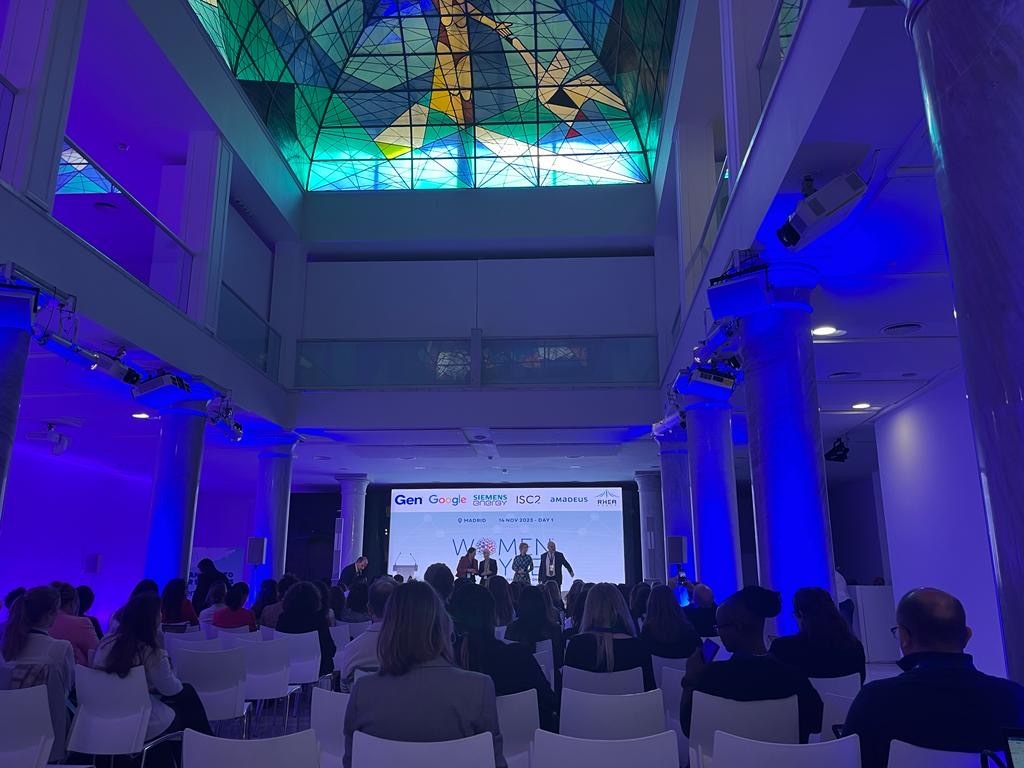Fortifying Global Cybersecurity: Embracing Diversity and Inclusion, with a Focus on Women’s Empowerment
- Categories Blog
- Date 05/01/2024

The era of digitalisation has ushered in profound transformations in our daily lives, work environments, and societal frameworks. Projections indicate a substantial surge in the number of Internet of Things (IoT) devices, set to nearly double from 15.1 billion in 2020 to surpass 29 billion by 2030 (Statista 2023). Beyond being mere statistical figures, these numbers paint a vivid picture of our imminent future. Notably, vital sectors like the food supply industry are undergoing a significant digital shift, relying more than ever on interconnected technologies. Simultaneously, our energy infrastructures are embracing digital technologies for smart production and efficient energy resource management. Anticipating the near future, the horizon is set for the widespread adoption of cooperative and intelligent transport systems, facilitating seamless information exchange among vehicles and with road infrastructure (European Commission 2023). The healthcare landscape is also undergoing rapid digitalisation, with Artificial Intelligence (AI) enhancing the intelligence of medical devices and remote patient monitoring prepared to alleviate the burden on hospitals (Martin 2023). While the narrative offers an optimistic view of the future, it’s crucial to acknowledge that the escalating number and intricacy of cyber threats have the potential to inflict not only substantial financial costs but also to critically compromise the foundational pillars of a digital society.
Rising Cyber Threats Targeting Critical Services and People
The surge in cyber threats poses a growing risk to critical services and individuals alike. Over the past decade, these threats have evolved to a point where they not only disrupt business operations but also jeopardise the essential infrastructures that underpin a digital society. Examples from recent years underscore the severity of the issue. In 2015, Ukraine experienced a sophisticated cyber-attack that resulted in a widespread electricity blackout. In 2022, Costa Rica declared a state of emergency, a historic first, following major ransomware attacks that paralysed tax and customs systems, disrupting import and export operations (Security Intelligence 2022). September 2023 witnessed a massive Distributed Denial of Service (DDoS) attack targeting a Russian airline’s booking system, causing significant delays in airport operations (The Record 2023). In December 2023, a nuclear power plant in the UK fell victim to a sophisticated cyber threat, compromising crucial activities like monitoring dangerous material leaks and fire checks (Isaac and Lawson 2023). The impact of cyber threats extends beyond critical infrastructures, as demonstrated in August 2023 when it was revealed that data on 40 million voters in the UK had been exposed to hackers, highlighting the potential threats posed by cyber interference to democratic institutions (Burton 2023). Given the expanding attack surface and the emergence of novel attack vectors, such as the malicious deployment of AI, it is improbable that cyber threats will diminish in the foreseeable future. This underscores the imperative for heightened international cooperation to foster a cybersecurity skill set that values diversity and inclusivity. The evident underrepresentation of women in this field serves as a wake-up call, emphasising the urgent need for initiatives that actively support and empower women to strengthen our collective cyber defence efforts.
The Increased Need for Cyber Talent Based on Diversity and Inclusiveness
While there isn’t a precise quantification of the demand for cyber talents, recent research indicates a significant gap between global demand and the capacity of the cyber workforce. In 2022, this gap was estimated to be 3.4 million people, marking a 26% increase compared to 2021 (McCann 2023). Looking ahead, Microsoft forecasts that by 2025, there will be 3.5 million open cybersecurity positions worldwide (Behncken 2022). These staggering figures underscore the urgent need to address the global cyber skills crisis. However, the underrepresentation of women in this sector, accounting for only 10-25% of the global cybersecurity workforce (Cyber Peace Institute 2022), further exacerbates the skills shortage. Various factors contribute to hindering women’s participation in the cybersecurity industry, including societal biases that perpetuate the notion that “men are more suited for the security industry” and non-inclusive working cultures that create barriers for women in the cyber field. Additionally, in some regions, women face more obstacles than men in accessing STEM education or digital literacy, further limiting their entry into the field.
Nevertheless, there is cause for optimism as a number of inspiring initiatives have emerged to champion women in the cybersecurity field. One notable example is Women4Cyber, an effort led by the European Union (EU) with the mission to promote, encourage, and support the active participation of women in cybersecurity. This foundation orchestrates a range of impactful activities, from mentorship programs to dedicated academic initiatives, all geared towards empowering women in the cyber domain. Notably, Women4Cyber extends beyond Brussels, with the establishment of national Women4Cyber Chapters designed to provide support at a local level. Presently, 25 national Women4Cyber Chapters have been established, enabling local experts to deepen their understanding of the unique cybersecurity landscapes in their respective regions and identify key priorities in the field. In a significant milestone for Women4Cyber, 2023 marked the inaugural general conference themed “Hacking Gender Barriers,” held in Madrid in November. The conference drew more than 300 participants and featured 30 speakers specialising in various facets of the cybersecurity field, ranging from risk managers to Chief Information Security Officers (CISOs). As the CyberMACS programme, we also take pride in showcasing our initiative at the conference. In an era where transnational cyber threats are on the rise, the significance of information sharing and exchanging best practices has never been more critical. Our participation in the Women4Cyber Conference reflects our commitment to collaborative efforts aimed at effectively addressing the challenges posed by cybersecurity on a global scale.
CyberMACS Is Raising Future Cyber Skills and Promote Women in Cyber Domain
As the number of initiatives targeting the global cybersecurity talent shortage continues to grow, with a specific emphasis on fostering inclusivity and diversity in the workforce, there remains a plethora of steps to be taken to ensure the security of our global digital future. In this context, CyberMACS stands out by offering a distinctive perspective on cybersecurity education. The programme not only highlights the imperative of international collaboration in raising cybersecurity talent but also underscores the critical need for diversity and increased participation of women in the field. CyberMACS is positioned to play a pivotal role in shaping a more resilient and inclusive future within the realm of cybersecurity education. In this vein, the programme is committed to achieving a balanced 50-50 gender representation in its future student editions. With an ambitious goal, CyberMACS aims to cultivate a diverse learning environment by aiming to admit a total of 130 students by the end of 2028. This commitment reflects the programme’s dedication to fostering gender equality and enhancing diversity in the field of cybersecurity.
Sources:
- Behncken, Kate. 2022. “Closing the Cybersecurity Skills Gap – Microsoft Expands Efforts to 23 Countries.” The Official Microsoft Blog. March 23, 2022. https://blogs.microsoft.com/blog/2022/03/23/closing-the-cybersecurity-skills-gap-microsoft-expands-efforts-to-23-countries/.
- Burton, Joe. 2023. “Cyber-Attacks against the UK Electoral Commission Reveal an Ongoing Threat to Democracy.” The Conversation. August 15, 2023. http://theconversation.com/cyber-attacks-against-the-uk-electoral-commission-reveal-an-ongoing-threat-to-democracy-211550.
- Cyber Peace Institute. 2022. “Why Are Women So Under-Represented in Cybersecurity?” CyberPeace Institute (blog). June 3, 2022. https://cyberpeaceinstitute.org/news/women-in-cybersecurity/.
- European Commission. 2023. “Key Technologies to Boost the Digitalisation of Transport | Shaping Europe’s Digital Future.” December 14, 2023. https://digital-strategy.ec.europa.eu/en/policies/technologies-digitalisation-transport.
- Isaac, Anna, and Alex Lawson. 2023. “Sellafield Nuclear Site Hacked by Groups Linked to Russia and China.” The Guardian, December 4, 2023, sec. Business. https://www.theguardian.com/business/2023/dec/04/sellafield-nuclear-site-hacked-groups-russia-china.
- Martin, Sarah. 2023. “Council Post: Three Ways Digitalization Is Powering The Future Of Healthcare.” Forbes. 2023. https://www.forbes.com/sites/forbestechcouncil/2023/03/16/three-ways-digitalization-is-powering-the-future-of-healthcare/.
- McCann, Megan. 2023. “The Quest To Close The Cybersecurity Talent Gap.” Forbes. 2023. https://www.forbes.com/sites/forbeshumanresourcescouncil/2023/10/16/the-quest-to-close-the-cybersecurity-talent-gap/.
- Security Intelligence. 2022. “Costa Rica State of Emergency Declared After Ransomware Attacks.” Security Intelligence. 2022. https://securityintelligence.com/news/costa-rica-state-emergency-ransomware/securityintelligence.com/news/costa-rica-state-emergency-ransomware.
- Statista. 2023. “IoT Connected Devices Worldwide 2019-2030.” Statista. 2023. https://www.statista.com/statistics/1183457/iot-connected-devices-worldwide/.
- The Record. 2023. “Russian Flight Booking System Suffers ‘Massive’ Cyberattack.” 2023. https://therecord.media/russia-flight-booking-system-leonardo-ddos.ccccccc



